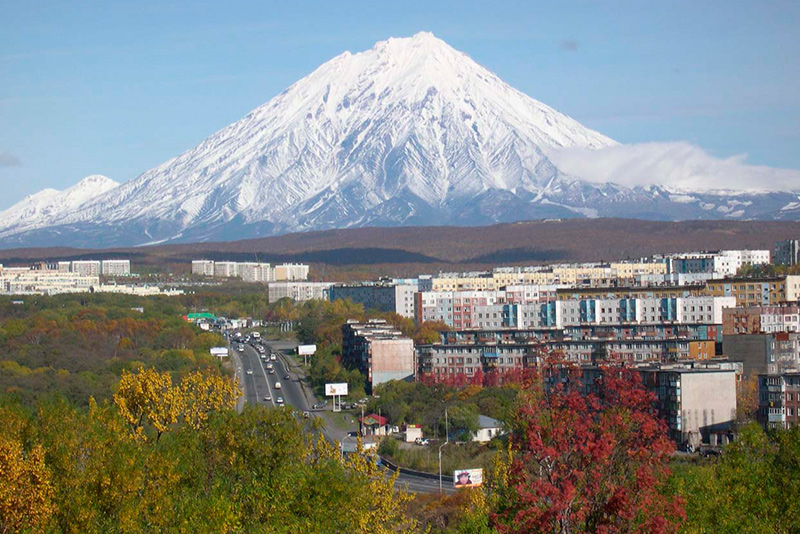 Adventures in the Russian Far East
Adventures in the Russian Far East
Last year, John Swindell from WILDFOOT travelled with his wife just about as far east as he could go for his best adventure so far, the Russian far East. This is the account of his trip which took in the various attractions of our Russian Far East itineraries.
Day 1
Petropavlovsk-Kamchatskiy
We met everyone over dinner last night. After breakfast there were a couple of optional excursions led by Katya and Chris from the expedition team. Katya took those who were interested on a guided tour of Petropavlovsk-Kamchatskiy which included a number of the visitor attractions of this icon town. Amongst the places visited was Lenin Square where there was a huge statue of the first leader during the Communist era.
The other option was a birding walk and this explored an area near the hotel where a range of good birds were found. We opted for the wander around town – we like birds, but there will be plenty to see later. Highlight this morning was a visit to the port office, where we sent a few postcards. A real throwback to another era, not only was there no English spoken, but the stamps had no adhesive, so the clerk had to glue each one individually to the postcard – 10 cards and 3 stamps to a card, not a happy bunny!
By 2 pm we were all aboard the Spirit of Enderby in time for a late lunch followed by a series of briefings. An introduction to the ship and expedition team was followed by a Zodiac briefing and the theoretical part of the safety drill. A little later, Expedition Leader Rodney explained that there would be a delay in our departure due to the worsening weather. This gave us all time to unpack and orientate ourselves around the ship. Later, we had lifeboat drill and this was the first time I had actually practised getting in to a lifeboat with a full complement – you really would not want to be adrift for long – it is very tight! After dinner, sailed out into Avacha Bay, which is considered to be one of the largest natural harbours in the world. A few beers and then bed, hoping the weather improves for the morning.
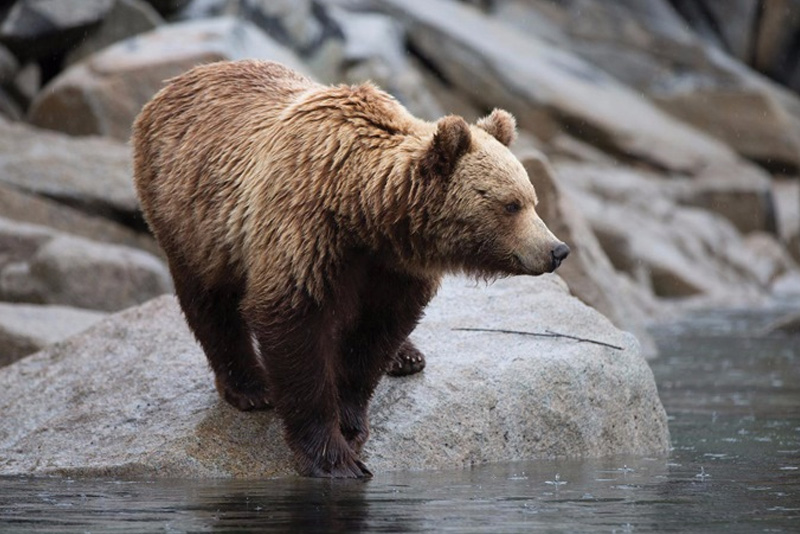
Day 2
Zhupanova River
The day began with blue skies, flat seas and little wind as we cruised northward towards the Zhupanova River.
Lots of birds to see including our first Tufted Puffins and one which is not that common along this stretch of coastline, the Ancient Murrelet. By the time breakfast was over, we were anchored off the mouth of the Zhupanova River and after a briefing from Rodney, we boarded five Zodiacs and set off for the river entrance. When we were part way there, a radio message came through from Adam that a Long-billed Murrelet had been spotted and all the Zodiac drivers quickly made a ‘bee line’ towards the indicated area. Entering the river mouth, there were lots of gulls loafing on the sand and whilst most of these were Slaty-backed Gulls, a lone Red-legged Kittiwake was spotted amongst them. A good start, along with a dozen Long-billed Curlews also feeding nearby. Once Rodney and Katya had spoken to the locals to confirm there were no restrictions on our activities, we set off up the river and some saw a single Aleutian Tern amongst the large numbers of Common Terns. Further upstream, a male Yellow-breasted Bunting was seen. This is quite a rare bird and after disappearing for a few moments, returned to the same perch after Chris played a recording of its song – cheating really!

Moving along the river we passed a group of Largha Seals, with their distinctive spotted markings, hauled out on a sandbar. Our main goal on this particular Zodiac cruise was to get some good looks at the spectacular Steller’s Sea Eagle. We had seen two in the distance when entering the river mouth, but the expedition team took us to two nests where we enjoyed some phenomenal views of this majestic raptor. After cruising several miles upstream, the Zodiacs headed back towards the fishing village and most of those who had missed the earlier Aleutian Tern got lucky when another was found perched on a piece of wood. It seemed utterly oblivious to several Zodiacs making increasing close passes and some excellent photos of this tricky species were taken. Landing at the river mouth, some went to investigate the village where we were invited to sample some of the salmon which had been caught along with bowls of red-coloured roe, whilst others went for a short walk to the wet grassland behind the village – this suited me, since I am not a lover of fishy things. Back to the ship and out to sea and towards the Commander Islands, the range of seabirds changed with good numbers of Laysan Albatrosses and Fork-tailed Storm-Petrels seen. Five species of cetacean were also spotted: Fin, Humpback, Sperm, Baird’s Beaked Whale and Dall’s Porpoise – although not very close. Also our first interesting lecture by Katya about the Commander Islands.
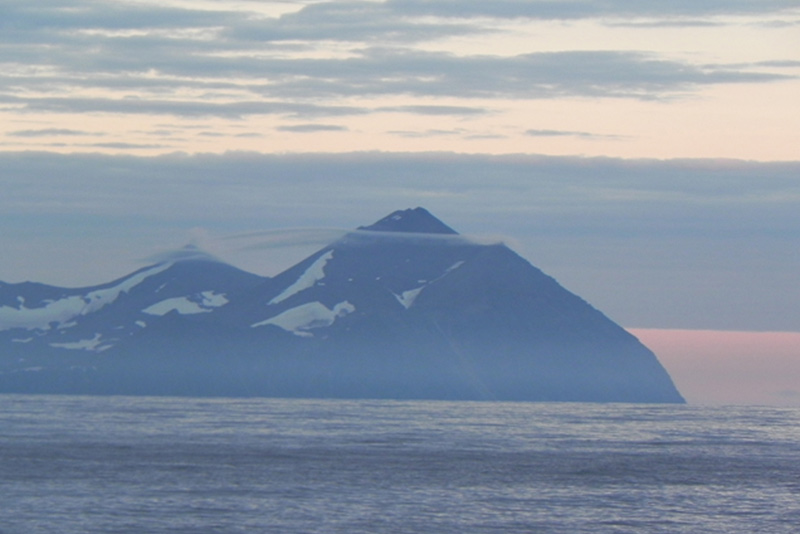
Day 3
Bering Island, Commander Islands
I’m told that there were some great cetacean sightings before breakfast this morning including a Humpback Whale tail slapping and at least one Sperm Whale. These were a bit early for me, but I am assured there will be more! As we closed in on Bering Island, the number of birds increased with loads of beautiful Tufted Puffins, as well as Common Guillemots, Blacklegged and Red-legged Kittiwakes and several Pelagic Cormorants. The undoubted highlight for the serious birders, however, was a juvenile Short-tailed Albatross which made a close pass in front of the bow during breakfast and most of them made it on to deck in time!
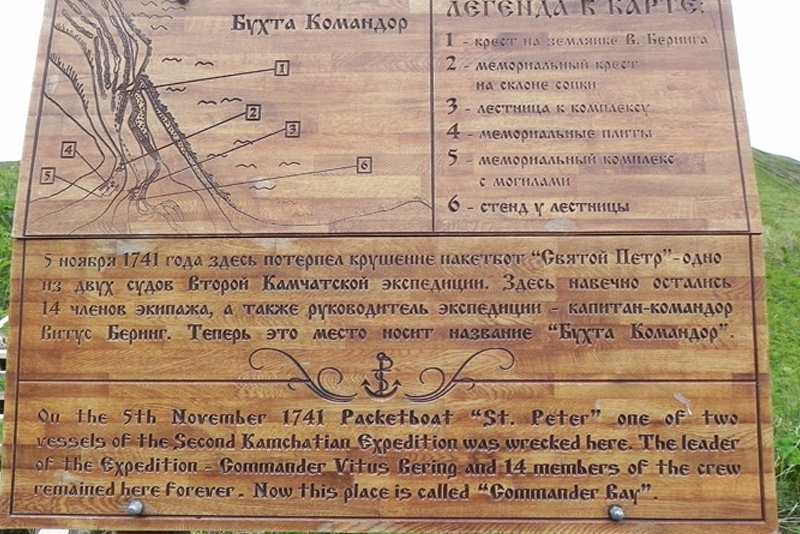
After a short briefing, our leader, Rodney set off with Katya, Natalia (who both speak Russian) and the Captain on a Zodiac to meet the local Border Guard who confirmed we could land provided everyone presented their passports to him. Amazing bureaucracy – we were told to take off any sunglasses and hats, be very serious and definitely take no photographs! With this procedure completed, we were free to explore. We were told that Nikol’skoye weather can be unpredictable, but we were lucky today as the clouds parted and the sun came out. Fascinating little settlement with cattle wandering in and out of the buildings and in the children’s playground! Went to the small museum in the middle of the town where there was a range of exhibits. These included the skeleton of a Steller’s Sea Cow which had become extinct within thirty years of the archipelago being discovered on the second of Bering’s expeditions which had landed on the Commander Islands in 1741. Bizarrely, there is also an eccentric resident artist called Sergei who has a gallery overlooking the bay – ended up buying one of his prints in a rusting metal frame, which should look good somewhere at home! Another stop and photo op, because the ship was anchored in the bay behind, was at the memorial statue to Vitus Bering. Although this great explorer had been the first to reach the Commander Islands, his ship was wrecked here in 1741. He survived the wreck but a month later succumbed to scurvy. The birders walked along the shoreline and saw a good range of species including Glaucous-winged Gull, Red-legged Kittiwake, Lapland and Snow Buntings, summer plumaged Dunlin and then later to great excitement a Mongolian Plover, Pechora Pipit and a Rock Sandpiper which was found just as the final Zodiacs were arriving to collect their passengers.
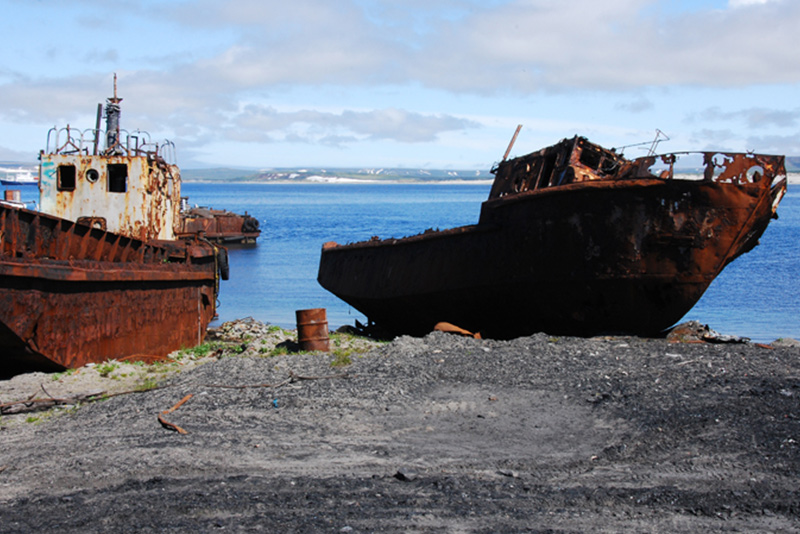
Over lunch, we repositioned to North West Cape and then set off for shore by zodiac – landing here was definitely wet with the low tide – I was lucky, the water did not come over the top of my willies! We climbed a quite steep grassy cliff to a couple of viewpoints where we watched literally hundreds of Northern Fur Seals, Harbour Seals and a few Steller Sea Lions. It was difficult to know where to look with mothers feeding tiny pups, bulls arguing with each other and the coming and going of others between the sea and sandy beach. At one point, two Arctic Foxes appeared on the beach, looking a bit ragged still having some of their winter coats attached. They came and went and then one of them was spotted in the long grass up the cliff nearby and stayed around posing for us. Then off to another spot to watch horned puffins and glaucus gulls close up.

After dinner, we got to make another zodiac landing on to Arij Karmen island which is no more than a few hundred metres long and absolutely crammed with breeding seabirds. Once again it was difficult to know where to look with Tufted Puffins, Pigeon Guillemots, Red-legged and Blacklegged Kittiwakes, Pelagic and Red-faced Cormorants amongst the species seen. I just love puffins and it reminded me of time on Skomer Island off Pembrokeshire when the Atlantic Puffins come back to nest. Heading a few hundred metres offshore, there were more birds to see as two of the smaller species of auks, Parakeet Auklet and Crested Auklet were rafting up prior to coming ashore after dark. By 9:30 pm big numbers were gathering and there was a single flock of ‘Parakeets’ which contained at least one thousand birds – a truly spectacular sight! At 10 pm it was becoming a bit gloomy so we returned to the ship, tired but quite elated – a great wildlife day.
Day 4
Peschayna & Commander Bays
We woke up to another beautiful morning in the Commander Islands, anchored off a Nature Reserve at the north eastern end of Medny Island. Apparantly, Medny has always been famous for its scenery and abundant wildlife. This was evident straight away with a huge flock of Northern Fulmars surrounding the ship and then both a Humpback and a Minke Whale were seen before we even got the Zodiacs in the water.
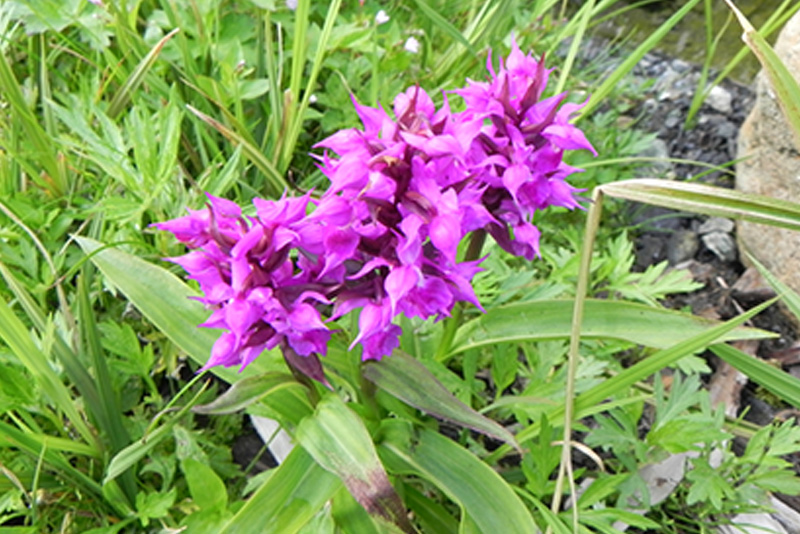
We landed next to the abandoned Border Guard station and village at Peschanaya Bay and spent time just wandering around. It really was atmospheric and a little sad. This was the last outpost of the Soviet empire, with the American Aleutian Islands being the next land to the east, so it must have been a real hardship posting for the troops based here. During ‘glasnost’ the post was abandoned and it looks like everybody just left – in the huts, there are beds, cupboards with tins of food and utensils and even girly calendars hangin g on the walls. Outside there are rusting vehicles, an old satellite dish and lots of barbed wire. There may have been civilians at one time but the only evidence is on the bleak hillside, where a lonely cemetery is gradually being reclaimed by nature. Remnants of wooden Orthodox crosses stand sentinel against the wind and rain. But there was also lots of life – wildflowers and thousands of birds nesting on the cliffs, notably shags and glaucous gulls. We were strangely reluctant to leave when the zodiacs returned.
Back on the ship a couple more Sperm Whales were seen as we cruised around the headland. During a Zodiac cruise later in the afternoon we saw Sea Otters and a large number of Harbour Seals in the kelp beds around the rocks. There were also hundreds of Horned Puffins nesting on the cliffs and Grey-crowned Rosy Finches feeding close to the waterfront. We then set a course for Bering Island again. On the way we had an escort from a few Humpback Whales and Laysan Albatross (much to the delight of the birders) which we watched from the decks.

Our last landing on these beautiful islands was in Commander Bay, where Bering’s expedition landed, wrecked and was forced to overwinter, suffering many hardships before re building their ship and sailing back to Kamchatka. They lost 31 crew and officers, including Bering himself, and some of them were buried on the island. There are several poignant memorials to the expedition and those who died on the island in the winter of 1741. It is now a peaceful place with beautiful wild flowers and lovely scenery, but you can still get a sense of what it must have been like in the winter and even in other seasons, when the weather can be equally vicious.

Day 5
Karaginskiy Island
Another splendid morning en route to Karaginsky Island. Even though it was very tempting to stay out on deck, we had two really interesting lectures this morning. The first was following on from our sightings the other day of sea otters and was about their biology and the history of hunting in the 19th and early 20th century for their fur, which all but wiped the species out in the region. Later, our Russian representatives from Birding International, Evgeny and Elena presented their very informative talk about biology and conservation of the Spoon-billed Sandpiper, which is one of the main objectives of our trip. They have been working with the species for over ten years and their knowledge is extensive. It was a very interesting, but also in many ways disturbing account of the species history, showing the rapid decline in numbers that only a huge conservation effort can remedy. They also showed video of breeding sandpipers and described a few points that we have to keep in mind while making our small contribution to the project during the voyage. Immediately after lunch we set out for the landing on Karaginsky Island where we spent three hours ashore in glorious sunny weather. Birding highlights included a Red-spotted Bluethroat, Dusky Warbler, Red-throated and Pechora Pipits and Pallas’s Reed Bunting, Wealso noted a good number of Long-tailed Skuas which were patrolling the tundra in search of prey. Overall it was a very successful birding day. After dinner we had a lecture from our guest speaker Dr Debbie Pain, who gave an excellent talk about the Spoon-billed Sandpiper captive breeding and head starting programs, run by the Wildfowl & Wetlands Trust in Slimbridge, UK. We learned about the research behind it, and the methods and logistical challenges the various teams had to manage. She showed a touching six minute film which followed the first year of the captive breeding operation,when the eggs and recently hatched chicks were transported to Anadyr on the Spirit of Enderby in 2011. We’re alI looking forward to doing our bit over the next few days.
Day 6
Verkhoturova Island and Govena Peninsula
We had an early morning start with a landing on Verkhoturova Island, which is famous not only for its bird colonies but also for their accessibility. After landing on the gravely beach we climbed a steep grassy slope and were blown away by the spectacle that opened to us. Puffins were just a few metres away, with kittiwakes and guillemots tightly packed on the cliffs just below us, while hundreds of Slaty-backed Gulls nested amongst the grass beside the track. We carefully approached the colony, making sure not to disturb or damage any birds or nests. Everyone found a spot to just sit and enjoy time with the birds. It was absolutely brilliant to be so close to so many birds, especially the puffins and have the time to sit and enjoy them. Amongst the activity we also saw a few Common Eiders and Steller’s Sea Eagles while a Red Fox checked us out from the beach. Great flocks of Crested and Parakeet Auklets flew overhead and we rather reluctantly made our way back to the zodiacs. During lunch the ship steamed towards the Govena Peninsula and Cape Primetniy (Conspicuous), which the expedition team have nicknamed ‘bear gully’. The area lived up to this name as even before we launched the Zodiacs, four bears were spotted on the shore. On the way we sailed round an old shipwreck, which now hosts a massive Slaty-backed Gull colony and took some good photos of the chicks whilst dodging the adults screaming round our heads. As we drew near to land the scheduled bear appeared and obligingly posed for photographs very close to the Zodiacs. After everyone had made the most of this super photo op,it strolled back inland. We spotted a second bear before heading back to the ship. Later the Spirit of Enderby was boarded by some of the reserve staff and border control officers. Despite the guns and knives they sported, they were pretty friendly and after all the formalities were over, left us to enjoy our dinner.
Day 7
Tintikun Lagoon
Another amazing cloudless day. Tintikun Lagoon is a quite magical place with beautiful scenery. The lagoon has a narrow and shallow entrance so we had to climb out of the zodiacs and walk for about twenty minutes while the zodiac drivers negotiated the shallows and took the boats up the creek. After watching bears watching us on the hillside across the river, we landed at various stops The birders were thrilled to see the elusive Siberian Accentor and Arctic and Dusky Warblers, along with White-winged Scoter. On the way back we saw yet another bear on the slopes racing across the hillside. As we made our way back we accepted an invitation from the rangers to visit one of their huts. These guys casually carried their machine guns and knives – because the area is remote and a reserve, there are poachers around and I’m not sure the rangers would be too fussy about taking prisoners!
Day 8
Tigil Lagoon
This was a big day in our search for the Spoon-billed Sandpiper. With Russian Ornithologists Evgeny and Elena on board, the really serious searching could now begin. We were divided into six teams and the ship was anchored off Tigil Lagoon all day to allow a comprehensive search of the area to cover as much ground as possible in search of this rare and elusive bird. Very early on at 05.30 a scout boat was dispatched into the early morning mist to prospect the search areas. Then, after breakfast, we were split into teams and each allocated an area to search, but unfortunately, landings were postponed until 11.30 due to weather conditions. When we did land, we formed ourselves into a long line. I had a walkie-talkie at one end of the line with one of the others at the other end, probably about 150 yards away. We then carefully swept the area, walking amongst the tussocks, hoping that we might just either flush a spoon-bill, or come across a nest. Despite this being what is considered ideal habitat, and the fact that we walked for several hours, we didn’t find evidence of any ‘Spoonies’. We did see some other birds, including a Willow Grouse and a Pallas’s Reed Bunting. An interesting day, nevertheless – we’ll try another area day after tomorrow.
Day 9
Bukhtas Petra, Pavla and Natalia

This turned out to be an absolutely superb day. Early in the morning we approached the fiord of Pavla Bay, one of the most beautiful locations along the Koryak coast. The sun was shining once again and there was just a slight breeze, so even before breakfast, we were out on deck looking at the majestic landscape of mountain ranges, peaks and gullies. Another briefing with three options today. We chose to go with Rodney for a three hour walk up from Pavla to Petra Bay. This really was superb – magnificent rolling scenery, walking through patches of snow, climbing to vantage points and picnicking by a tarn. Then, on reaching Petra Bay, there was the ship, having made it way around, anchored there in the blue water at the end of the fjord. Not only did we get to see a couple of Asian Rosy Finches, but on the hillside we also spotted a very rare and elusive Snow Sheep. We walked down to the shore to be picked up by the zodiacs and then set sail for only about half an hour to where one of the other groups had been birding. This was another of those really interesting but rather sad places. It was the remains of a fish processing factory, which had actually been a labour camp for women convicts in the Soviet era. It is only accessible by sea and there were two watchtowers and lots of barbed wire around, even though attempts at escape would have been futile – even now, there were fresh bear footprints on the dusty tracks. We walked amongst the ruins and the rusting vehicles of this forlorn place, imagining how much worse it must have been in the winter! Spirits were raised a little, however by the sighting of a nest of three young white Gyrfalcons – very rare and very beautiful. Then some Dusky Thrushes, Red-flanked Bluetails and Little Buntings. It was an incredible day.
Day 10
Opuka Lagoon and Maliuvieem Lagoon
By morning we were anchored off the mouth of the Opuka Lagoon. Hopes were high as we were in ideal Spoon-billed Sandpiper habitat today and Grey Whales spouted off the entrance to the lagoon. Off we went after breakfast and spent a long day walking the crowberry spits and moraine hills of this vast area, while the ship shifted to deploy a fourth team at Maliuvieem Lagoon, another spot considered ideal for the elusive ‘Spoonies’. We covered miles of ground, again without success, but it was still really interesting. At one point, we came across an area near the beach where there were masses of whale bones, including huge vertebrae. Also, the remains of a hut used by bear hunters and some bear bones. We did have to retreat a couple of times when bears appeared on the hillside or on the shoreline, sometimes as close as 50 yards or so – these brown bears are not known to be aggressive towards humans and, because of all the hunters, are more likely to avaoid us, but better not to take any chances! A long and busy day out on the tundra!
Find out about all our trips to Russia’s Far East here
